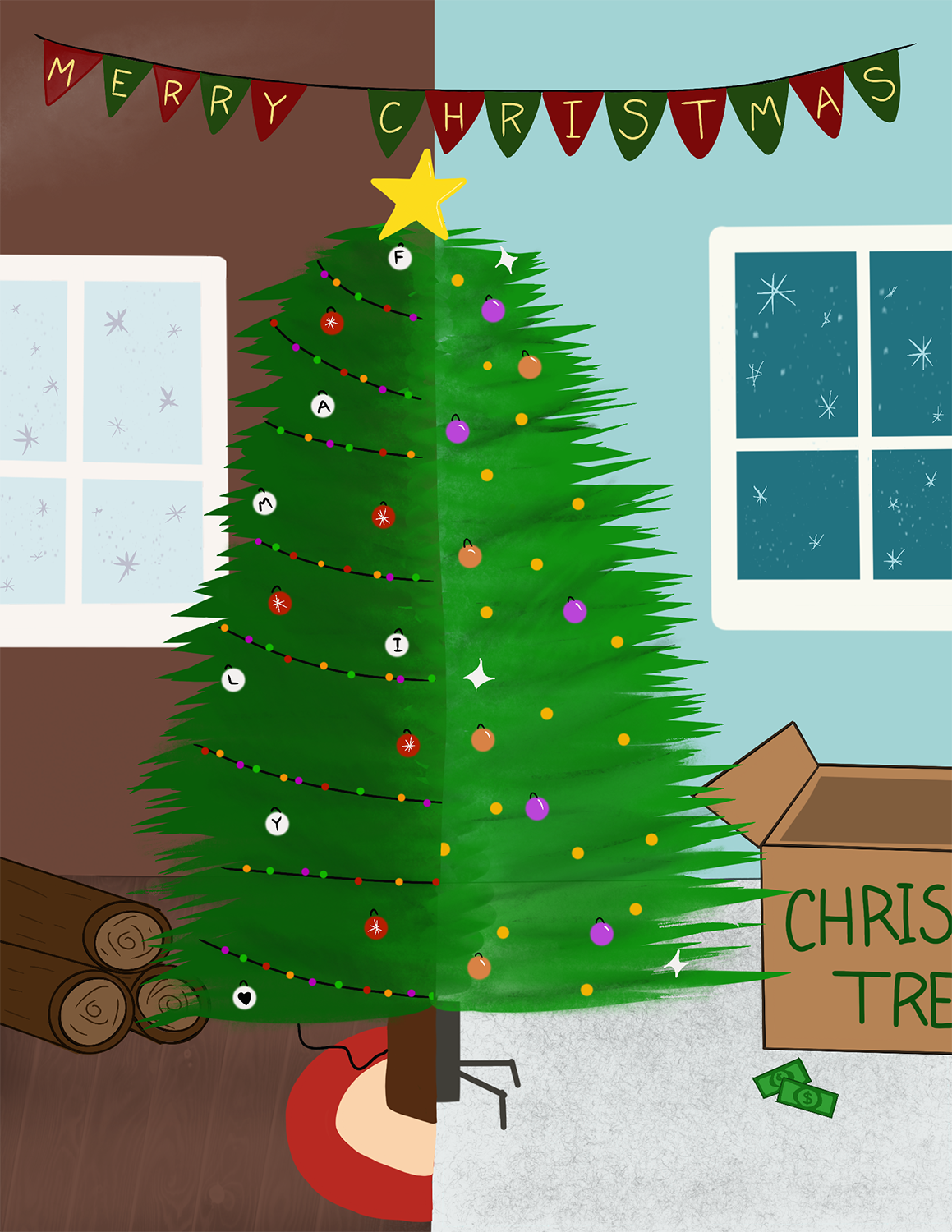The Great Debate: Which is the better choice: a real or fake Christmas tree?
December 23, 2021
Fake trees are cheaper and more convenient.
The season of Christmas is finally upon us; amidst the flurry of gift-giving, travel and celebration, there’s another conundrum that Christmas has presented us with—Christmas trees.
While the piney, naturalistic aroma of an evergreen tree is enticing, having an artificial or plastic tree is not only easier for your family but easier on your wallet as well.
This holiday season, having a faux tree provides the best gift of all— a return on investment. Unlike a real tree, having an artificial tree can be reused and redecorated as many times as one may please. Year after year, families won’t have to worry about when and where to get the “perfect” tree; instead, it is lying readily available in your basement.
For those who relish the opportunity to pick out their own tree, dissatisfaction often comes fast as there is never the “perfect” tree that will fit all your needs. While Mother Nature cannot always customize to your needs, humans can.
For whatever Blue Spruce or Kingswood fir that suits you best this Christmas season, human-made trees offer the gift of an already pre-lit tree adorned with fabulous decorations and, of course, the best gift of all—the gift of saving money.
ABC News reports that “one of the biggest advantages that come to mind when purchasing an artificial Christmas tree is the cost savings; it’s cheaper to have a fake tree every year because the same tree goes up. You only have to buy that tree once.”
Lastly, the clutter of leaves, dirt, and bugs that Christmas trees bring into your home is hard to ignore. Alongside the unremitting burden of watering the gigantic plant, the haphazard collection of needles and other foreign droppings that plunge from the tree also remains a holiday hamper.
Nonetheless, by purchasing a fake tree, the once high-maintenance house plant would be, in contrast, anything but.
The hassle of watering the tree, trimming its branches, and sweeping its relentless mess is too much for a few weeks of holiday celebrations.
Additionally, safety is of the utmost importance for those families with young children. When contemplating whether or not to buy a fake tree, it is essential to keep in mind that artificial trees are often fire-resistant.
According to the National Fire Protection Association (from Fox23 News), “real Christmas trees are three times more likely to be involved in a Christmas tree fire, compared to artificial trees.”
Composed mainly of fire-resistant materials, with artificial trees, you would no longer have to worry about safely stringing the tree lights as you now are void of any potential disasters.
Real Christmas trees are the better, more sustainable option
For many, the end of Thanksgiving marks the official start of the Christmas season. Lights are hung from houses, holiday decorations start to appear practically everywhere, and many families set out to find that perfect Christmas tree for the holiday season.
However, there is still debate as to what type of tree is better: real or fake.
There is, of course, a very easy answer to this argument. Real trees are vastly superior to fake trees, for several reasons.
Firstly, going to pick out a real tree is an experience the whole family can enjoy. I often look back on these memories and look forward to making new ones in coming years; going out in the afternoon, picking out a unique tree (with hot cocoa, of course), and bringing it home to decorate. The alternative to this is going to your local department store and choosing one of the many identical fake trees sitting in boxes on a shelf. That is certainly not the same experience.
Additionally, real Christmas trees are better for the environment. For every real tree harvested, one to three seedlings are planted the following spring. According to the University of Vermont’s Department of Plant and Soil Science, one acre of Christmas trees provides enough oxygen for 18 people every day. Real trees also absorb carbon dioxide while they grow, which helps to reduce the impacts of climate change. On the other hand, 85% of artificial trees are made in China, according to the National Christmas Tree Association. Transporting these trees overseas consumes oil and fuel and releases carbon emissions, further contributing to the issue of climate change.
And yes, real trees are a more expensive option. However, these costs outweigh the potential hefty, long-term environmental burden that fake trees can bring. For example, fake trees cannot be recycled. Artificial trees are made with harmful chemicals including lead, metal and polyvinyl chloride (PVC), a non-biodegradable plastic, whose pollution is a leading cause of cancer. After disposing of an artificial tree, it will lay in landfills for centuries.
Conversely, there are endless options of ways to dispose of real trees. They can be recycled as mulch, compost or wildlife shelters. The Rockefeller Center’s Christmas tree is even used to build houses, according to the Rockefeller Center.
Some may also claim that using real trees causes deforestation. However, this view is incorrect. The fact is, real trees are often farmed on marginal land that can’t be used for other purposes.
There are many other benefits to getting a real tree for the holiday season, but for sake of time, I will leave you with this: if you celebrate Christmas (or just want a festive, wonderful piney smelling tree in your home) and want to remain guilt-free for the test of time, buy a real tree.

Jula began writing for The Harbinger her freshman year after taking Journalism. While at first hesitant, she grew to love reporting and specifically opinion...


